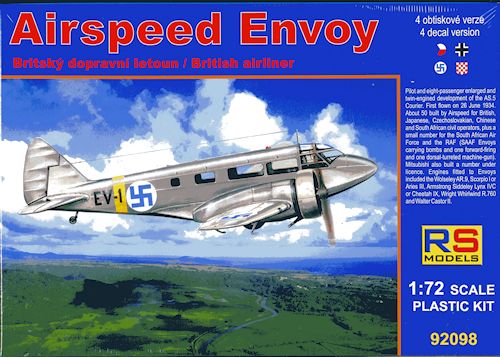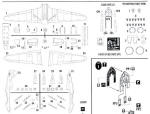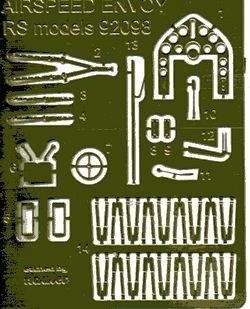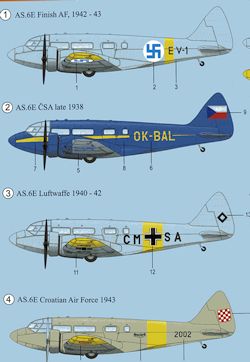
RS Models 1/72 Airspeed Envoy
| KIT #: | 92098 |
| PRICE: | $25.17 on sale ($39.95 SRP) |
| DECALS: | Four options |
| REVIEWER: | Scott Van Aken |
| NOTES: | Short run with photo etch and resin parts |

| HISTORY |
The first production Envoy I, G-ACVH, flew in October 1934 and was used as a company demonstrator. The second, also a Series I but fitted with Wolseley Aries III radial engines, was delivered to Lord Nuffield. This aircraft was due to fly in the MacRobertson Air Race from England to Australia in 1934 but the aircraft was damaged and withdrawn from the race. Another aircraft, a specially modified version with long-range tanks (the AS 8 Viceroy) got as far as Athens before leaving the race due to damage. One Envoy took part in the Schlesinger Race to Johannesburg, but crashed, killing two of a crew.
Orders soon came from the whole Commonwealth. Two aircraft went to the Ansett Airlines in Australia. North Eastern Airways and Olley Air Service in the UK also used the AS.6. In Czechoslovakia, the CSA ordered four AS.6 Envoy JC in 1937.
In May 1937, the British King George VI traded the de Havilland Dragon Rapide of the King's Flight for an Airspeed AS.6J Envoy III. The AS.6's good stability and flaps, as well as its low landing speed (less than 100 km/h) was decisive. The aircraft received the registration G-AEXX and was painted in distinctive red and blue colours.
The Airspeed AS.6 Envoy also entered the Air Forces of different countries. The British Royal Air Force used a few AS.6 in a military configuration. The aircraft was used in the Air Forces of Spain, Japan, South Africa, Finland and China and some others. Seven machines were ordered for joint use by the South African Air Force and South African Airways, with three being delivered in military form and four delivered to South African Airways, where they were used on the air route between Johannesburg - Bloemfontein - Port Elizabeth on 12 October 1936. Each of these seven aircraft could be transformed by a work crew of four within four hours from the transport version into a light bomber or reconnaissance aircraft. In this configuration the crew consisted of four; pilot, navigator, radio operator and gunner.
In October 1936, the British Air Ministry ordered 136 Envoys for crew training. These further developed aircraft were given a new company designation as the AS.10 and entered RAF service as the Airspeed Oxford.
During the Spanish Civil War, ten AS.6 Envoys were obtained by the Spanish Republicans, with the Nationalist side using two, including one that defected from the Republicans, as transport, reconnaissance aircraft or light bombers.
During the Second World War, the German Luftwaffe captured some machines and used them as trainer aircraft. The Luftwaffe gave one aircraft to Finland on 22 January 1942, as reparation for the accidental shooting down of a Finnish de Havilland Dragon Rapide. This aircraft was used between 1942 and 1943. Likewise, one aircraft was used between 1941 to 1943 by the Slovaks.
| THE KIT |
 This
one from RS Models is a standard multi-media short run kit. You all know about
the usual in terms of how nice the external detailing is and the need to clean
up the big bits and test fit everything so I'll go right on to the features.
First off, this one has a relatively extensive clear suite for a short run kit
that includes a nicely molded but somewhat distorted cockpit transparency and a
pair of cabin windows. This latter bit is a tad different than you might expect
in that the cabin windows also include that part of the outer fuselage. You
place these onto the fuselage and then attach the upper fuselage atop it. While
it eliminates a clear strip on the inner fuselage, it makes it difficult to
tackle any seams you may have as there is very little 'fuselage' around each
window.
This
one from RS Models is a standard multi-media short run kit. You all know about
the usual in terms of how nice the external detailing is and the need to clean
up the big bits and test fit everything so I'll go right on to the features.
First off, this one has a relatively extensive clear suite for a short run kit
that includes a nicely molded but somewhat distorted cockpit transparency and a
pair of cabin windows. This latter bit is a tad different than you might expect
in that the cabin windows also include that part of the outer fuselage. You
place these onto the fuselage and then attach the upper fuselage atop it. While
it eliminates a clear strip on the inner fuselage, it makes it difficult to
tackle any seams you may have as there is very little 'fuselage' around each
window.
 Backing up a
bit, the cockpit has a single seat (no copilot on these) with an etched harness
as well as an etched instrument panel and rudder pedals. Instruments are on an
acetate sheet that fits behind the instrument panel. The seat sits right in the
middle of the opening to the cabin which makes me wonder how the pilot got into
it. There is also a control wheel and what looks like a landing gear lever and
flap lever on the pilot's right. Both of these and the base into which they fit
are p.e. The cabin has a pair of rear walls and seven airline style seats.
Backing up a
bit, the cockpit has a single seat (no copilot on these) with an etched harness
as well as an etched instrument panel and rudder pedals. Instruments are on an
acetate sheet that fits behind the instrument panel. The seat sits right in the
middle of the opening to the cabin which makes me wonder how the pilot got into
it. There is also a control wheel and what looks like a landing gear lever and
flap lever on the pilot's right. Both of these and the base into which they fit
are p.e. The cabin has a pair of rear walls and seven airline style seats.
Back at the rest of the airframe, you have a single
lower with with two upper wing halves; pretty standard stuff. The kit has a
number of lower engine nacelles, but since this is the Castor engine powered
plane, apparently only one set applies. The upper engine nacelle is resin as are
the engines. In fact, this is one of the deals where you get a crankcase and
have to attach each of the individual cylinders. The rocker arm pushrods are
photo etch and the exhaust collector is resin. A resin engine ring and crankcase
cover are supplied. The latter may be optional with some markings
 options, but
again, none is specified.
options, but
again, none is specified.
Each of the main landing gear assemblies looks rather complex and consists of four pieces per side. Detail drawings are supplied. Each kit has four sets of prop blades. Two sets are different pitch from the other two and in this case, the instructions are specific on which markings option uses which blades.
Instructions are well drawn and provide generic color
information. As these are basically airliners, there are no weapons options.
Four markings options are provided with the painting and markings guide on the
back of the box. One is an actual airliner with the CSA in 1938 with a blue
fuselage and tailplane along
 with the
leading edges of the wings and engine nacelles. The rest of the wings are in
silver. One option is Finnish with yellow fuselage and lower wing tips. This
appears to be in silver as does the Luftwaffe option (which is listed as
1940-42, but has Eastern Front ID markings). Also in Eastern Front markings is a
Croatian plane from 1943. This one appears to be in overall RLM 02. Decals are
well printed and are very thin.
with the
leading edges of the wings and engine nacelles. The rest of the wings are in
silver. One option is Finnish with yellow fuselage and lower wing tips. This
appears to be in silver as does the Luftwaffe option (which is listed as
1940-42, but has Eastern Front ID markings). Also in Eastern Front markings is a
Croatian plane from 1943. This one appears to be in overall RLM 02. Decals are
well printed and are very thin.
| CONCLUSIONS |
As is the norm with RS models, this aircraft is in several boxings, depending on the engine, I'll wager. It is a nice looking airplane and while not really that well known to most modelers, should make for an excellent model when one is done.
| REFERENCES |
http://en.wikipedia.org/wiki/Airspeed_Envoy
August 2013
Thanks to your editor for finding this one on sale.
If you would like your product reviewed fairly and fairly quickly, please contact the editor or see other details in the Note to Contributors.